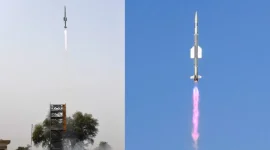- Views: 4K
- Replies: 13
India's strategic military power is set for a substantial upgrade following the first successful test of an 800-kilometre range version of the BrahMos supersonic cruise missile.
According to official sources, the test, conducted in the Bay of Bengal earlier in 2025, confirmed the missile's enhanced capabilities, paving the way for its induction into the armed forces within the next two to three years.
The new long-range missile, designated BrahMos-LR, marks a major milestone for the nation's defence posture. It provides the Indian military with the ability to execute precision strikes on high-value targets located deep within enemy territory from safer standoff distances.
This development significantly strengthens India's strategic deterrence and reshapes the military balance in the South Asian region.
The breakthrough test was carried out from a naval warship and demonstrated the missile’s capacity to engage both land and sea targets with exceptional accuracy.
During the test, the BrahMos-LR performed complex manoeuvres while travelling at its characteristic supersonic speed of nearly Mach 3. This achievement is a triumph for BrahMos Aerospace, the successful joint venture between India’s DRDO and Russia’s NPO Mashinostroyeniya.
This range extension was made possible by India's admission into the Missile Technology Control Regime (MTCR) in June 2016. Prior to joining the MTCR, the BrahMos missile's range was limited to 290 kilometres.
Post-membership, developers were able to first create a 450km variant (BrahMos-ER) in 2017, and have now nearly doubled that capability with the 800km BrahMos-LR. The extended range was achieved primarily by redesigning the missile to hold more fuel for its advanced ramjet engine.
Known for its incredible speed, stealthy design, and "fire-and-forget" guidance system, the BrahMos is considered one of the most difficult cruise missiles to intercept.
The 800km range gives the Indian armed forces unprecedented operational flexibility. The Indian Navy can now target enemy vessels from a much safer distance in the Indian Ocean, while the Army can hold strategic assets deep inside neighbouring territories at risk.
Furthermore, the Indian Air Force (IAF) plans to integrate the new variant with its Sukhoi-30 MKI fighter jets, creating a formidable aerial strike platform.
Looking ahead, BrahMos Aerospace has scheduled a series of multi-phase trials commencing in 2026. These tests are designed to validate the missile's propulsion, guidance, and overall reliability under diverse operational scenarios.
Following the successful completion of these trials, mass production will begin, with formal induction into the forces anticipated by 2027-2028. The armed forces have already outlined significant procurement plans for the new variant.
This project also represents a major success for the "Make in India" initiative in defence. The BrahMos-LR features critical indigenous components, including a domestically developed radar seeker and advanced fuel systems, reducing reliance on foreign parts.
A new BrahMos Integration and Testing Facility in Lucknow, completed in 2025, will further bolster self-reliance by supporting the production of these advanced missiles.
Development is also underway for a future hypersonic version, the BrahMos-II, which is projected to have a range of 1,500km and travel at speeds exceeding Mach 6.





